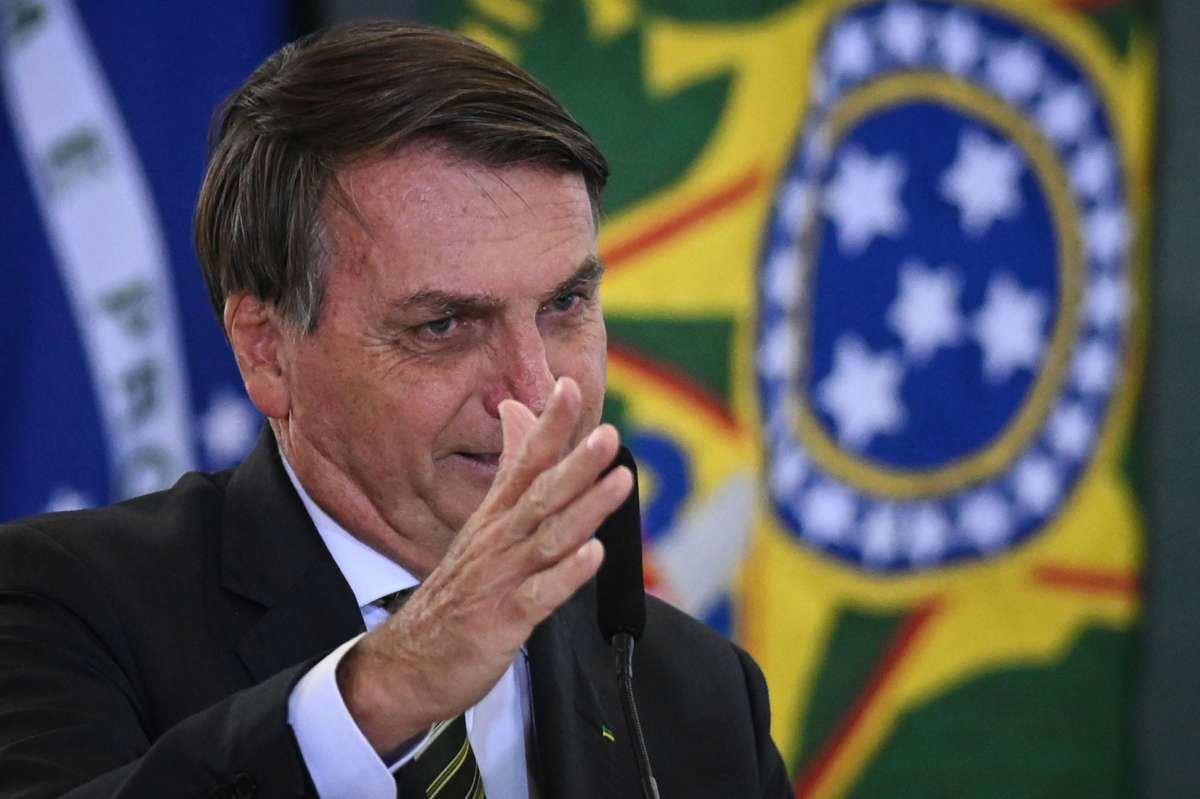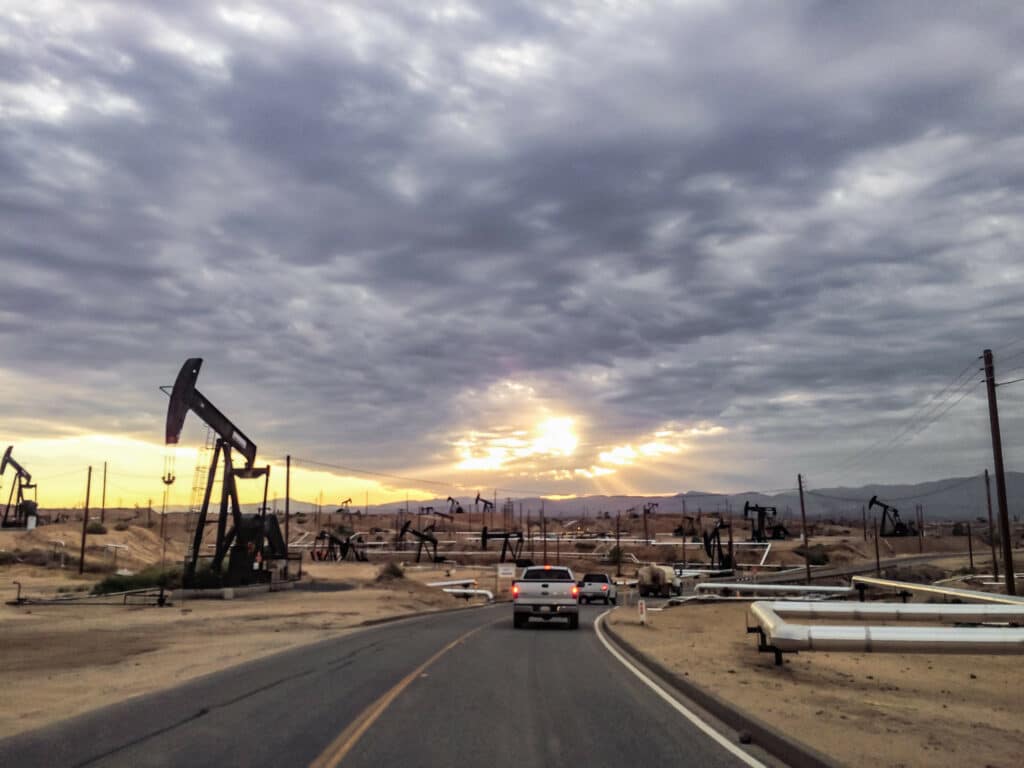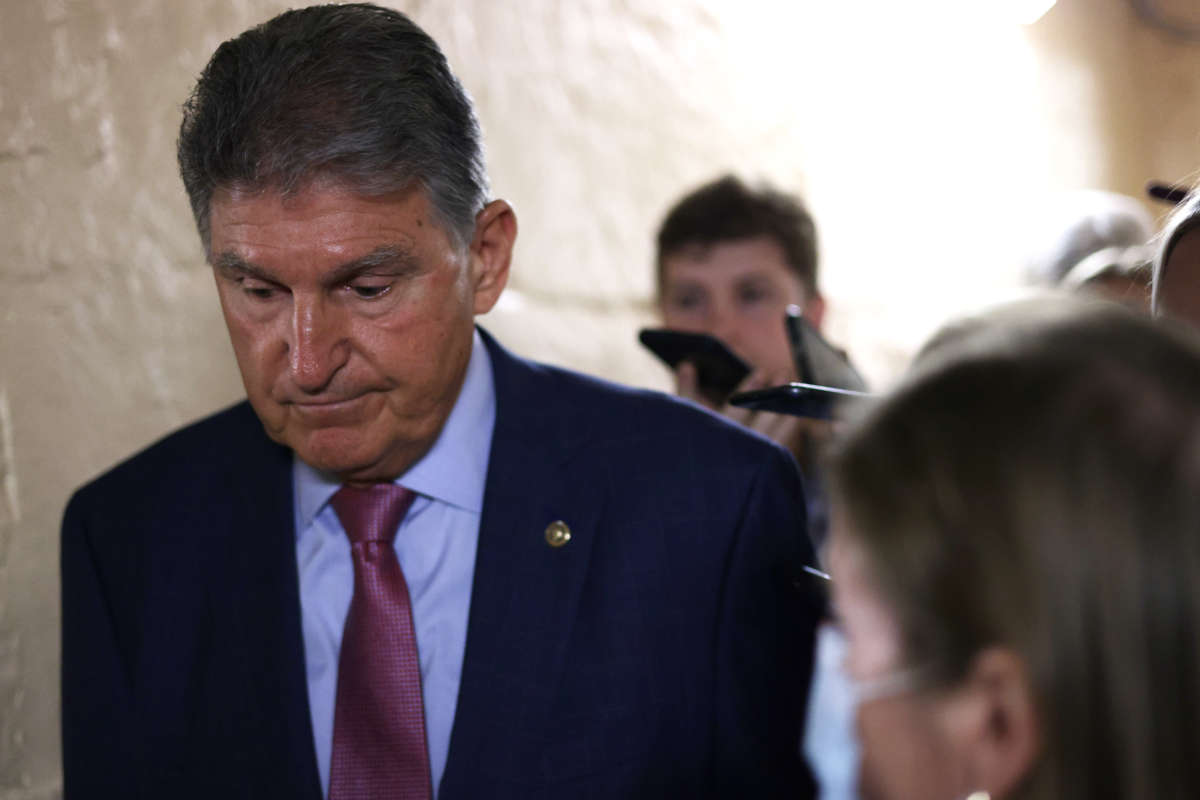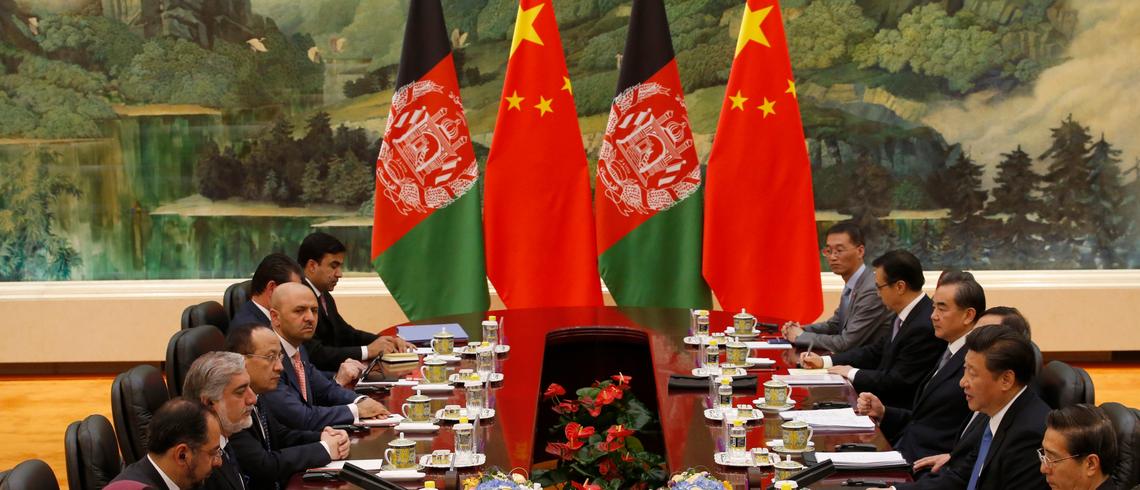
Brazil's President Jair Bolsonaro speaks during the launch ceremony of the platform Participa + Brasil, at the Planalto Palace, in Brasilia, Brasil, on February 8, 2020.ANDRE BORGES / NURPHOTO VIA GETTY IMAGES
BYC.J. Polychroniou, Truthout
BYC.J. Polychroniou, Truthout
PUBLISHED July 16, 2021
Since 2019, Brazil finds itself in the midst of one of its most difficult periods since the end of the military dictatorship in 1985, thanks to the inhumane policies of the Jair Bolsonaro regime which parallel those of Donald Trump’s administration. President Bolsonaro is an apologist for the brutal military dictatorship that ruled Brazil from 1964 to 1985, and there is even the possibility that he may attempt to resort to the military guys who he thinks might back him up in the face of growing opposition to his handling of the pandemic.
Noam Chomsky has followed closely Brazilian and Latin American politics for many decades, and even visited Brazil’s former president Luiz Inácio Lula da Silva in prison in 2018. In this interview, he discusses the factors that brought Bolsonaro to power, dissects his policies and compares them to the Trump regime, and assesses what the future may hold for the troubled nation.
C.J. Polychroniou: Jair Bolsonaro — an apologist for torture and dictatorship and part of the global trend towards authoritarianism that brought us Donald Trump — was sworn in as president of Brazil on January 1, 2019. Since that day, his administration has been pushing an agenda with disastrous consequences for democracy and the environment. I want to start by asking you of the conditions in Brazil that brought Bolsonaro to power, a development which coincided with the end of the “pink tide” that had swept across Latin America in the early 2000s.
Noam Chomsky: A lot is uncertain and documentation is slim, but the way it looks to me is basically like this.
With the fall of commodity prices a few years after Lula da Silva left office in 2010, the Brazilian right wing — with U.S. encouragement, if not direct support — recognized an opportunity to return the country to their hands and to reverse the welfare and inclusiveness programs they despised. They proceeded to carry out a systematic “soft coup.” One step was impeaching Lula’s successor, Dilma Rousseff, in utterly corrupt and fraudulent proceedings. The next was to imprison Lula on corruption charges, preventing him from running in (and almost surely winning) the 2018 presidential election. That set the stage for Bolsonaro to be elected on a wave of an incredible campaign of lies, slanders and deceit that flooded the internet sites that most Brazilians use as a main source of “information.” There’s reason to suspect a significant U.S. hand.
The charges against Lula were withdrawn by the courts after they were completely discredited by Glenn Greenwald’s exposure of the shenanigans of the prosecution in connivance with “anti-corruption” (Car Wash) investigator Sergio Moro. Before the exposures, Moro had been appointed Minister of Justice and Public Security by Bolsonaro, perhaps a reward for his contributions to his election. Moro has largely disappeared from sight with the collapse of his image as the intrepid white knight who would save Brazil from corruption — while, probably not coincidentally, destroying major Brazilian businesses that were competitors to U.S. corporations (which are not exactly famous for their purity).
Though Moro’s targets were selective, much of what he revealed is credible — and not difficult to find in Latin America, where corruption is practically a way of life in the political and economic worlds. One can, however, debate whether it attains the level that is familiar in the West, where major financial institutions have been fined tens of billions of dollars, usually in settlements that avoid individual liability. One indication of what the scale might be was given by the London Economist, which found over 2000 corporate convictions from 2000-2014. That’s just “corporate America,” which has plenty of company elsewhere. Furthermore, the notion of “corruption” is deeply tainted by ideology. Much of the worst corruption is “legal,” as the legal system is designed under the heavy hand of private power.
Despite Moro’s own corruption, much of what he unearthed was real and had been for a long time. His main target, Lula’s Workers Party (PT), it appears, did not break this pattern. Partly for this reason, the PT lost an opportunity to introduce the kinds of lasting progressive changes that are badly needed to undermine the rule of Brazil’s rapacious and deeply racist traditional ruling classes.
Lula’s programs were designed so as not to infringe seriously on elite power, but they were nonetheless barely tolerated in these circles. Their flaw was that they were oriented towards the needs of those suffering bitterly in this highly inegalitarian society. The basic character of Lula’s programs was captured in a 2016 World Bank study of Brazil, which described his time in office as a “golden decade” in Brazil’s history. The Bank praised Lula’s “success in reducing poverty and inequality and its ability to create jobs. Innovative and effective policies to reduce poverty and ensure the inclusion of previously excluded groups have lifted millions of people out of poverty.” Furthermore,
Brazil has also been assuming global responsibilities. It has been successful in pursuing economic prosperity while protecting its unique natural patrimony. Brazil has become one of the most important emerging new donors, with extensive engagements particularly in Sub-Saharan Africa, and a leading player in international climate negotiations. Brazil’s development path over the past decade has shown that growth with shared prosperity, but balanced with respect for the environment, is possible. Brazilians are rightly proud of these internationally recognized achievements.
Some Brazilians. Not those who consider it their right to wield power in their own interest.
Brazil became an effective voice for the Global South in international affairs, not a welcome development in the eyes of Western leaders, and a particular irritant to the Obama-Biden-Clinton administration when Brazil’s foreign minister Celso Amorim came close to negotiating a settlement on Iran’s nuclear programs, undercutting Washington’s intent to run the show on its own terms.
The Bank report also concluded that with proper policies, the “golden decade” could have persisted after the collapse of commodity prices. That was not to be, however, as the soft coup proceeded. Some analysts have suggested that a crucial turning point was when Dilma announced that profits from newly discovered offshore oil reserves would be directed to education and welfare instead of the eager hands of international investors.
The PT had failed to sink social roots, to such an extent that beneficiaries of its policies were often unaware of their source, attributing the benefits to God or to luck. The corruption, failure of mobilization and lack of structural reform all contributed to Bolsonaro’s electoral victory.
Bolsonaro’s victory was welcomed with enthusiasm by international capital and finance. They were particularly impressed by Bolsonaro’s economic czar, ultra-loyal Chicago economist Paulo Guedes. His program was very simple: in his words, “Privatize Everything,” a bonanza for foreign investors. They were, however, disillusioned as Brazil collapsed during the Bolsonaro years and Guedes’s promises remained unfulfilled.
Let’s talk now specifically about some of Bolsonaro’s policies, which have been denounced by activists, economists and organizations such as Human Rights Watch, as well as by Indigenous leaders. And how would you compare his policies to those of Donald Trump?
The analogy is apt. Trump was Bolsonaro’s unconcealed model, though not the only one. In casting his vote to impeach Dilma, he dedicated it to her torturer during the military dictatorship. That’s a level of depravity that even his hero Trump didn’t reach. His admiration for the dictatorship is also unconcealed, though he does have some criticisms of the military. His prime complaint is that they were too mild. They should have killed 30,000 people as the military did in Argentina next door. He has also criticized the behavior of the military in earlier years. They should have imitated the U.S. cavalry, which virtually eliminated the Native population. Instead, the Brazilian military left remnants in the Amazon. But Bolsonaro has made it quite clear that he intends to overcome that problem.
Like Trump, Bolsonaro’s most important policy commitments, by far, are to destroy the prospects for organized human life in the interest of short-term profits for his friends — in his case, mining, agribusiness and illegal logging that have sharply accelerated the destruction of the Amazon forests. Scientists had anticipated, pre-Bolsonaro, that in a few decades, the Amazon would shift from one of the world’s greatest carbon sinks to a carbon source, as it transitions from tropical forest to savannah. Thanks to Bolsonaro, that point may already be approaching. For Brazil, the effects will be devastating. Rainfall will sharply decline, with much of the rich agricultural land turning to desert. The world as a whole will suffer a severe blow, a wound that might prove to be lethal. For the Indigenous inhabitants of the forest, the outcome is genocidal.
As elsewhere in the world, the Indigenous in Brazil have been in the forefront for years in trying to protect human society from the depredations of “advanced civilization.” But time is growing short, and if the Trumps and Bolsonaros of the world are granted free rein, chances of decent survival are slim.
Again, as in the case of Trump, Bolsonaro’s malevolence is not exhausted by his commitment to destroy organized human society — along with the innumerable species that we are quickly driving to extinction. Like Trump, he can claim personal responsibility for tens (if not hundreds) of thousands of COVID deaths, to mention one salient contribution to the welfare of his country. Police killings, overwhelmingly with Black victims, have long been a plague, mounting under Bolsonaro. A particularly shocking recent incident of military assault on a Rio favela reached international headlines.
All too easy to continue.
What is the likelihood that Bolsonaro could face charges in The Hague over the Amazon?
Virtually none. His contributions to global suicide may be particularly severe, but once that door is opened…
Who is going to allow that?
Brazilians took to the streets recently demanding the removal of Bolsonaro over his handling of the pandemic. Indeed, it seems that public opinion has finally turned overwhelmingly against Bolsonaro, and Lula is expected to trounce him in the 2022 elections. However, in a rather unsurprising manner, and reminiscent of his idol Trump, Bolsonaro announced just a few days ago that he may not accept the results of the 2022 election under the current voting system. How likely is the chance that the generals, on whom Bolsonaro has relied on from the first day he got into power, will stay the course and support an attempt of his to stay in power even if he loses next year’s presidential election?
Since 2018, Bolsonaro has been claiming that the only way he can be defeated in an election is by fraud. He’s even claimed (of course, without evidence) that Dilma actually lost the 2014 election, which she won handily by over 3 million votes, mostly on sharp class lines, by historical standards a slim margin. He’s now stepped up the rhetoric, preemptively charging the 2022 election with attempted fraud by his political enemies and telling a crowd of supporters a few weeks ago that, “Elections next year will be clean. Either we have clean elections in Brazil or we don’t have elections” (Jornal do Brasil, 7-08-21).
Not exactly unfamiliar.
Right now, Lula is well ahead in the polls, just as in 2018, when measures were taken to bar his candidacy. There are legitimate concerns of a recurrence.
Parliamentary inquiries into the devastating mishandling of the pandemic by Bolsonaro’s government are now reportedly reaching the military. The three branches of the armed services recently released a statement declaring that no inquiry that impugns the honor of the military will be tolerated.
There have been reports of steps that might be preparation for a military coup, perhaps modeled on the 1964 coup that installed the first of the vicious “National Security States” that terrorized the hemisphere for 20 years.
The pretext for overthrowing the mildly reformist Goulart government in 1964 was the ritual appeal to save the country from “Communism.” Something similar could be concocted today.
How would Washington react? There are precedents that suggest an answer. One is 1964. The military coup that overthrew the parliamentary government was lauded by Kennedy-Johnson Ambassador to Brazil Lincoln Gordon as “the most decisive victory for freedom in the mid-twentieth century.” As I discuss in Year 501, it was a “democratic rebellion” that would help in “restraining left-wing excesses” and should “create a greatly improved climate for private investment” in the hands of the “democratic forces” now in charge. After 21 years of rule, Latin America scholar Stephen Rabe comments in The Most Dangerous Area in the World, the “democratic forces” left the country in “the same category as the less developed African or Asian countries when it came to social welfare indices” (malnutrition, infant mortality, etc.), with conditions of inequality and suffering rarely matched elsewhere, but a grand success for foreign investors and domestic privilege.
That’s putting aside the “systematic use of torture” and other crimes of state documented by the Church-run Truth Commission during the dictatorship’s last days.
We should also recall that the reaction to the Brazil coup — and possible involvement in it — was no exception. Rather, it was the norm after 1962, when JFK changed the mission of the Latin American military from anachronistic “hemispheric defense” to very live “internal security.” The predictable results were described by Charles Maechling, who led U.S. counterinsurgency and internal defense planning from 1961 to 1966. Kennedy’s 1962 decision, he wrote, shifted the U.S. stand from toleration “of the rapacity and cruelty of the Latin American military” to “direct complicity” in their crimes, to U.S. support for “the methods of Heinrich Himmler’s extermination squads.”
Those who might innocently believe that things have changed can turn to the Obama-Clinton reaction to the military coup in Honduras in 2009, overthrowing the mildly reformist Zelaya government. Their support for the coup, almost alone, helped turn Honduras into one of the murder capitals of the world, stimulating a flood of terrified refugees now cruelly and illegally turned back at the U.S. border, if they can make it that far through the barriers imposed by U.S. clients.
The rich and ugly record might suggest something about Washington’s possible reaction to actions by the Brazilian military to “save the country from Communism.”
Peruvians elected as their president last month Pedro Castillo, a teacher and labor union leader, but the far right opponent Keiko Fujimori and her supporters are refusing the accept the outcome by crying fraud, allegations which have been rejected by international observers and while both the European Union and the United States praised the conduct of the election. But in places like Chile and Colombia, the right is also under pressure by citizens fed up with neoliberalism. Is another “pink tide” in the making across South America?
In Chile, a remarkable popular uprising is seeking to free the country at last from the clutches of the Pinochet dictatorship, a criminal enterprise backed even more strongly than usual by the U.S., with particular enthusiasm by the “libertarians” who then turned to launching the global neoliberal assault of the past 40 years. Colombia is being subjected to yet another renewal of the state and paramilitary violence escalated by Kennedy in 1962, when his military mission to Colombia, led by Marine Gen. William Yarborough, recommended “paramilitary sabotage and/or terrorist activities against known communist proponents,” which “should be backed by the United States” — as it has been through many horrifying years, recently Clinton’s Plan Colombia.
There is turmoil and uncertainty throughout the hemisphere, including “the colossus of the North.” What happens here will, as always, have enormous impact.
This interview has been lightly edited for clarity and length.
C.J. Polychroniou is a political economist/political scientist who has taught and worked in numerous universities and research centers in Europe and the United States. Currently, his main research interests are in European economic integration, globalization, climate change, the political economy of the United States, and the deconstruction of neoliberalism’s politico-economic project. He is a regular contributor to Truthout as well as a member of Truthout’s Public Intellectual Project. He has published scores of books, and his articles have appeared in a variety of journals, magazines, newspapers and popular news websites. Many of his publications have been translated into several foreign languages, including Arabic, Croatian, Dutch, French, Greek, Italian, Portuguese, Russian, Spanish and Turkish. His latest books are Optimism Over Despair: Noam Chomsky On Capitalism, Empire, and Social Change, an anthology of interviews with Chomsky originally published at Truthout and collected by Haymarket Books; Climate Crisis and the Global Green New Deal: The Political Economy of Saving the Planet (with Noam Chomsky and Robert Pollin as primary authors); and The Precipice: Neoliberalism, the Pandemic, and the Urgent Need for Radical Change, an anthology of interviews with Chomsky originally published at Truthout and collected by Haymarket Books (scheduled for publication in June 2021).
Since 2019, Brazil finds itself in the midst of one of its most difficult periods since the end of the military dictatorship in 1985, thanks to the inhumane policies of the Jair Bolsonaro regime which parallel those of Donald Trump’s administration. President Bolsonaro is an apologist for the brutal military dictatorship that ruled Brazil from 1964 to 1985, and there is even the possibility that he may attempt to resort to the military guys who he thinks might back him up in the face of growing opposition to his handling of the pandemic.
Noam Chomsky has followed closely Brazilian and Latin American politics for many decades, and even visited Brazil’s former president Luiz Inácio Lula da Silva in prison in 2018. In this interview, he discusses the factors that brought Bolsonaro to power, dissects his policies and compares them to the Trump regime, and assesses what the future may hold for the troubled nation.
C.J. Polychroniou: Jair Bolsonaro — an apologist for torture and dictatorship and part of the global trend towards authoritarianism that brought us Donald Trump — was sworn in as president of Brazil on January 1, 2019. Since that day, his administration has been pushing an agenda with disastrous consequences for democracy and the environment. I want to start by asking you of the conditions in Brazil that brought Bolsonaro to power, a development which coincided with the end of the “pink tide” that had swept across Latin America in the early 2000s.
Noam Chomsky: A lot is uncertain and documentation is slim, but the way it looks to me is basically like this.
With the fall of commodity prices a few years after Lula da Silva left office in 2010, the Brazilian right wing — with U.S. encouragement, if not direct support — recognized an opportunity to return the country to their hands and to reverse the welfare and inclusiveness programs they despised. They proceeded to carry out a systematic “soft coup.” One step was impeaching Lula’s successor, Dilma Rousseff, in utterly corrupt and fraudulent proceedings. The next was to imprison Lula on corruption charges, preventing him from running in (and almost surely winning) the 2018 presidential election. That set the stage for Bolsonaro to be elected on a wave of an incredible campaign of lies, slanders and deceit that flooded the internet sites that most Brazilians use as a main source of “information.” There’s reason to suspect a significant U.S. hand.
The charges against Lula were withdrawn by the courts after they were completely discredited by Glenn Greenwald’s exposure of the shenanigans of the prosecution in connivance with “anti-corruption” (Car Wash) investigator Sergio Moro. Before the exposures, Moro had been appointed Minister of Justice and Public Security by Bolsonaro, perhaps a reward for his contributions to his election. Moro has largely disappeared from sight with the collapse of his image as the intrepid white knight who would save Brazil from corruption — while, probably not coincidentally, destroying major Brazilian businesses that were competitors to U.S. corporations (which are not exactly famous for their purity).
Though Moro’s targets were selective, much of what he revealed is credible — and not difficult to find in Latin America, where corruption is practically a way of life in the political and economic worlds. One can, however, debate whether it attains the level that is familiar in the West, where major financial institutions have been fined tens of billions of dollars, usually in settlements that avoid individual liability. One indication of what the scale might be was given by the London Economist, which found over 2000 corporate convictions from 2000-2014. That’s just “corporate America,” which has plenty of company elsewhere. Furthermore, the notion of “corruption” is deeply tainted by ideology. Much of the worst corruption is “legal,” as the legal system is designed under the heavy hand of private power.
Despite Moro’s own corruption, much of what he unearthed was real and had been for a long time. His main target, Lula’s Workers Party (PT), it appears, did not break this pattern. Partly for this reason, the PT lost an opportunity to introduce the kinds of lasting progressive changes that are badly needed to undermine the rule of Brazil’s rapacious and deeply racist traditional ruling classes.
Lula’s programs were designed so as not to infringe seriously on elite power, but they were nonetheless barely tolerated in these circles. Their flaw was that they were oriented towards the needs of those suffering bitterly in this highly inegalitarian society. The basic character of Lula’s programs was captured in a 2016 World Bank study of Brazil, which described his time in office as a “golden decade” in Brazil’s history. The Bank praised Lula’s “success in reducing poverty and inequality and its ability to create jobs. Innovative and effective policies to reduce poverty and ensure the inclusion of previously excluded groups have lifted millions of people out of poverty.” Furthermore,
Brazil has also been assuming global responsibilities. It has been successful in pursuing economic prosperity while protecting its unique natural patrimony. Brazil has become one of the most important emerging new donors, with extensive engagements particularly in Sub-Saharan Africa, and a leading player in international climate negotiations. Brazil’s development path over the past decade has shown that growth with shared prosperity, but balanced with respect for the environment, is possible. Brazilians are rightly proud of these internationally recognized achievements.
Some Brazilians. Not those who consider it their right to wield power in their own interest.
Brazil became an effective voice for the Global South in international affairs, not a welcome development in the eyes of Western leaders, and a particular irritant to the Obama-Biden-Clinton administration when Brazil’s foreign minister Celso Amorim came close to negotiating a settlement on Iran’s nuclear programs, undercutting Washington’s intent to run the show on its own terms.
The Bank report also concluded that with proper policies, the “golden decade” could have persisted after the collapse of commodity prices. That was not to be, however, as the soft coup proceeded. Some analysts have suggested that a crucial turning point was when Dilma announced that profits from newly discovered offshore oil reserves would be directed to education and welfare instead of the eager hands of international investors.
The PT had failed to sink social roots, to such an extent that beneficiaries of its policies were often unaware of their source, attributing the benefits to God or to luck. The corruption, failure of mobilization and lack of structural reform all contributed to Bolsonaro’s electoral victory.
Bolsonaro’s victory was welcomed with enthusiasm by international capital and finance. They were particularly impressed by Bolsonaro’s economic czar, ultra-loyal Chicago economist Paulo Guedes. His program was very simple: in his words, “Privatize Everything,” a bonanza for foreign investors. They were, however, disillusioned as Brazil collapsed during the Bolsonaro years and Guedes’s promises remained unfulfilled.
Let’s talk now specifically about some of Bolsonaro’s policies, which have been denounced by activists, economists and organizations such as Human Rights Watch, as well as by Indigenous leaders. And how would you compare his policies to those of Donald Trump?
The analogy is apt. Trump was Bolsonaro’s unconcealed model, though not the only one. In casting his vote to impeach Dilma, he dedicated it to her torturer during the military dictatorship. That’s a level of depravity that even his hero Trump didn’t reach. His admiration for the dictatorship is also unconcealed, though he does have some criticisms of the military. His prime complaint is that they were too mild. They should have killed 30,000 people as the military did in Argentina next door. He has also criticized the behavior of the military in earlier years. They should have imitated the U.S. cavalry, which virtually eliminated the Native population. Instead, the Brazilian military left remnants in the Amazon. But Bolsonaro has made it quite clear that he intends to overcome that problem.
Like Trump, Bolsonaro’s most important policy commitments, by far, are to destroy the prospects for organized human life in the interest of short-term profits for his friends — in his case, mining, agribusiness and illegal logging that have sharply accelerated the destruction of the Amazon forests. Scientists had anticipated, pre-Bolsonaro, that in a few decades, the Amazon would shift from one of the world’s greatest carbon sinks to a carbon source, as it transitions from tropical forest to savannah. Thanks to Bolsonaro, that point may already be approaching. For Brazil, the effects will be devastating. Rainfall will sharply decline, with much of the rich agricultural land turning to desert. The world as a whole will suffer a severe blow, a wound that might prove to be lethal. For the Indigenous inhabitants of the forest, the outcome is genocidal.
As elsewhere in the world, the Indigenous in Brazil have been in the forefront for years in trying to protect human society from the depredations of “advanced civilization.” But time is growing short, and if the Trumps and Bolsonaros of the world are granted free rein, chances of decent survival are slim.
Again, as in the case of Trump, Bolsonaro’s malevolence is not exhausted by his commitment to destroy organized human society — along with the innumerable species that we are quickly driving to extinction. Like Trump, he can claim personal responsibility for tens (if not hundreds) of thousands of COVID deaths, to mention one salient contribution to the welfare of his country. Police killings, overwhelmingly with Black victims, have long been a plague, mounting under Bolsonaro. A particularly shocking recent incident of military assault on a Rio favela reached international headlines.
All too easy to continue.
What is the likelihood that Bolsonaro could face charges in The Hague over the Amazon?
Virtually none. His contributions to global suicide may be particularly severe, but once that door is opened…
Who is going to allow that?
Brazilians took to the streets recently demanding the removal of Bolsonaro over his handling of the pandemic. Indeed, it seems that public opinion has finally turned overwhelmingly against Bolsonaro, and Lula is expected to trounce him in the 2022 elections. However, in a rather unsurprising manner, and reminiscent of his idol Trump, Bolsonaro announced just a few days ago that he may not accept the results of the 2022 election under the current voting system. How likely is the chance that the generals, on whom Bolsonaro has relied on from the first day he got into power, will stay the course and support an attempt of his to stay in power even if he loses next year’s presidential election?
Since 2018, Bolsonaro has been claiming that the only way he can be defeated in an election is by fraud. He’s even claimed (of course, without evidence) that Dilma actually lost the 2014 election, which she won handily by over 3 million votes, mostly on sharp class lines, by historical standards a slim margin. He’s now stepped up the rhetoric, preemptively charging the 2022 election with attempted fraud by his political enemies and telling a crowd of supporters a few weeks ago that, “Elections next year will be clean. Either we have clean elections in Brazil or we don’t have elections” (Jornal do Brasil, 7-08-21).
Not exactly unfamiliar.
Right now, Lula is well ahead in the polls, just as in 2018, when measures were taken to bar his candidacy. There are legitimate concerns of a recurrence.
Parliamentary inquiries into the devastating mishandling of the pandemic by Bolsonaro’s government are now reportedly reaching the military. The three branches of the armed services recently released a statement declaring that no inquiry that impugns the honor of the military will be tolerated.
There have been reports of steps that might be preparation for a military coup, perhaps modeled on the 1964 coup that installed the first of the vicious “National Security States” that terrorized the hemisphere for 20 years.
The pretext for overthrowing the mildly reformist Goulart government in 1964 was the ritual appeal to save the country from “Communism.” Something similar could be concocted today.
How would Washington react? There are precedents that suggest an answer. One is 1964. The military coup that overthrew the parliamentary government was lauded by Kennedy-Johnson Ambassador to Brazil Lincoln Gordon as “the most decisive victory for freedom in the mid-twentieth century.” As I discuss in Year 501, it was a “democratic rebellion” that would help in “restraining left-wing excesses” and should “create a greatly improved climate for private investment” in the hands of the “democratic forces” now in charge. After 21 years of rule, Latin America scholar Stephen Rabe comments in The Most Dangerous Area in the World, the “democratic forces” left the country in “the same category as the less developed African or Asian countries when it came to social welfare indices” (malnutrition, infant mortality, etc.), with conditions of inequality and suffering rarely matched elsewhere, but a grand success for foreign investors and domestic privilege.
That’s putting aside the “systematic use of torture” and other crimes of state documented by the Church-run Truth Commission during the dictatorship’s last days.
We should also recall that the reaction to the Brazil coup — and possible involvement in it — was no exception. Rather, it was the norm after 1962, when JFK changed the mission of the Latin American military from anachronistic “hemispheric defense” to very live “internal security.” The predictable results were described by Charles Maechling, who led U.S. counterinsurgency and internal defense planning from 1961 to 1966. Kennedy’s 1962 decision, he wrote, shifted the U.S. stand from toleration “of the rapacity and cruelty of the Latin American military” to “direct complicity” in their crimes, to U.S. support for “the methods of Heinrich Himmler’s extermination squads.”
Those who might innocently believe that things have changed can turn to the Obama-Clinton reaction to the military coup in Honduras in 2009, overthrowing the mildly reformist Zelaya government. Their support for the coup, almost alone, helped turn Honduras into one of the murder capitals of the world, stimulating a flood of terrified refugees now cruelly and illegally turned back at the U.S. border, if they can make it that far through the barriers imposed by U.S. clients.
The rich and ugly record might suggest something about Washington’s possible reaction to actions by the Brazilian military to “save the country from Communism.”
Peruvians elected as their president last month Pedro Castillo, a teacher and labor union leader, but the far right opponent Keiko Fujimori and her supporters are refusing the accept the outcome by crying fraud, allegations which have been rejected by international observers and while both the European Union and the United States praised the conduct of the election. But in places like Chile and Colombia, the right is also under pressure by citizens fed up with neoliberalism. Is another “pink tide” in the making across South America?
In Chile, a remarkable popular uprising is seeking to free the country at last from the clutches of the Pinochet dictatorship, a criminal enterprise backed even more strongly than usual by the U.S., with particular enthusiasm by the “libertarians” who then turned to launching the global neoliberal assault of the past 40 years. Colombia is being subjected to yet another renewal of the state and paramilitary violence escalated by Kennedy in 1962, when his military mission to Colombia, led by Marine Gen. William Yarborough, recommended “paramilitary sabotage and/or terrorist activities against known communist proponents,” which “should be backed by the United States” — as it has been through many horrifying years, recently Clinton’s Plan Colombia.
There is turmoil and uncertainty throughout the hemisphere, including “the colossus of the North.” What happens here will, as always, have enormous impact.
This interview has been lightly edited for clarity and length.
C.J. Polychroniou is a political economist/political scientist who has taught and worked in numerous universities and research centers in Europe and the United States. Currently, his main research interests are in European economic integration, globalization, climate change, the political economy of the United States, and the deconstruction of neoliberalism’s politico-economic project. He is a regular contributor to Truthout as well as a member of Truthout’s Public Intellectual Project. He has published scores of books, and his articles have appeared in a variety of journals, magazines, newspapers and popular news websites. Many of his publications have been translated into several foreign languages, including Arabic, Croatian, Dutch, French, Greek, Italian, Portuguese, Russian, Spanish and Turkish. His latest books are Optimism Over Despair: Noam Chomsky On Capitalism, Empire, and Social Change, an anthology of interviews with Chomsky originally published at Truthout and collected by Haymarket Books; Climate Crisis and the Global Green New Deal: The Political Economy of Saving the Planet (with Noam Chomsky and Robert Pollin as primary authors); and The Precipice: Neoliberalism, the Pandemic, and the Urgent Need for Radical Change, an anthology of interviews with Chomsky originally published at Truthout and collected by Haymarket Books (scheduled for publication in June 2021).













